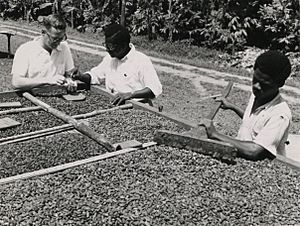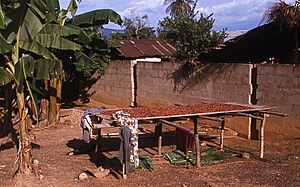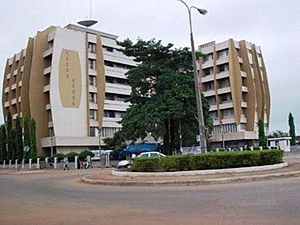Cocoa production in Ghana facts for kids
Ghana is a country in West Africa that is famous for its cocoa beans. These beans are used to make chocolate! Ghana is the second-largest exporter of cocoa beans in the world, right after Côte d'Ivoire. Together, these two countries produce a huge amount of the world's cocoa. The government of Ghana helps cocoa farmers through an organization called COCOBOD.
Contents
Where Cocoa Grows in Ghana
Cocoa plants need a lot of rain to grow well. In Ghana, cocoa farms are found in the country's forested areas. These include regions like Ashanti, Brong-Ahafo, Central, Eastern, Western, and Volta. These areas get about 1,000 to 1,500 millimeters of rain each year.
The cocoa farming year usually starts in October. This is when farmers begin to sell their main harvest. A smaller harvest, called the mid-crop, starts in July.
Most cocoa in Ghana is grown by small farmers. They usually have farms that are less than three hectares (about 7.4 acres) in size. All the cocoa grown in Ghana is sold to the Cocoa Marketing Board at set prices. This helps keep things fair for farmers.
Supporting Cocoa Farmers
Over the years, the government has made changes to help cocoa farmers. They used to transport the crops themselves, but now private companies help with this. Also, the government stopped giving money to farmers for things like fertilizers and insecticides.
A new payment system was started in 1982. It's called the Akuafo Check System. Before this, farmers sometimes had trouble getting paid for their cocoa. Now, farmers get a check that they can cash at any bank they choose. This makes sure they get their money quickly and safely.
In the past, Ghana was the world's biggest cocoa producer. But in the early 1980s, production dropped a lot. This was due to older trees, diseases, bad weather, and low prices for farmers. Big fires in 1983 also destroyed many cocoa farms. Since then, Ghana has worked hard to increase its cocoa production again.
The Cocobod has made it easier for private companies to buy cocoa from farmers. They pay farmers a good price and also cover the costs for buyers to transport the cocoa. Cocobod still handles shipping and exporting cocoa overseas. This helps make sure the cocoa is of high quality.
The government also helps farmers plant new trees. They give out seedlings to replace old trees or those lost in droughts. They also work to improve roads. Better roads make it easier for farmers to transport their cocoa to market. Experts are also trying to help farmers grow more cocoa per hectare. They provide advice, research new ways to fight diseases, and encourage the use of fertilizers. All these efforts have helped cocoa production grow since the 1990s.
Recent Growth in Cocoa Production
From 2000 to 2003, Ghana's cocoa production grew by about 16 percent each year. Growing cocoa takes a long time. New types of cocoa trees need over five years to start producing beans. They need another 10 to 15 years to produce their full amount.
Even with this growth, Ghana's cocoa farms don't produce as much per area as some other countries. Researchers have looked at why production has increased. Some important reasons include:
- Using new land for farming.
- More family members helping with farm work.
- Good rainfall.
- Better use of farm spraying and fertilizers.
Some studies suggest that farmers are not always using the newest farming methods. Instead, they are expanding their farms onto new land. This can be risky because new land might not stay fertile for long. Using more family labor can also make farming more expensive.
Cocoa farming is very important for many people in Ghana. Especially in rural areas, it provides a main source of income. Recently, the government has given more help to farmers. This has encouraged young people to expand their farms and plant more cocoa. Also, the world price for cocoa has gone up. This means farmers earn more money, which helps their families and the country.
How Cocoa Farming is Managed
The Ghana Cocoa Board has tried new ways of managing cocoa sales. While the government still controls all cocoa exports, there are now about 25 private companies that buy cocoa from farmers.
This mix of government and private companies has helped increase cocoa production. Companies compete to buy more cocoa. Farmers often choose to sell to companies that pay them quickly in cash. There are five main companies that buy cocoa:
- PBC (which used to be government-owned).
- Kuapa Kokoo (a successful farmer-owned group that follows fair trade rules).
- Adwumapa (a Ghanaian buying company).
- Olam and Armajaro (foreign-owned companies).
Farmers who live far from the main markets often find it easier to sell to PBC.
This system benefits everyone involved:
- The government earns more money from taxes on cocoa exports.
- The traders compete to buy more cocoa from farmers.
- The farmers are guaranteed a minimum price for their cocoa, no matter where their farm is.
Experts say that these changes have been good for farmers. They have more choices of buyers and get paid quickly. Their prices also stay stable throughout the farming season.
In 2018, Ghana and Côte d'Ivoire started a joint effort called the Côte d'Ivoire – Ghana Cocoa Initiative. This shows how important cocoa is to both countries.
Protecting Cocoa from Climate Change
In 2011, people involved in Ghana's cocoa production started a program called "climate-smart cocoa" (CSC). This program aims to reduce the effects of climate change on cocoa crops. One main idea was to give farmers shade tree seedlings. These trees help protect cocoa plants from too much heat and not enough water. They also make the soil healthier.
The program has helped, but there are challenges. Farmers sometimes don't have clear rights to the trees they plant. This means they might not want to spend time and money caring for shade trees if they don't feel they truly own them.
Harvesting Cocoa
Farmers carefully remove cocoa pods from the cocoa trees. They use special blades or hooks for this. Once the pods are off the tree, they are usually left in a pile. On a day when friends and family can help, often a Saturday, they work together. They crack open the pods with tools like machetes and take out the seeds.
A common way to ferment the cocoa beans is called the "heap method." This means leaving the beans in a pile and covering them with plantain leaves. After the beans have fermented, they are dried in the sun on raised mats.
Challenges in Cocoa Production
Child Labor Concerns
Sadly, a big issue in West Africa, including Ghana, is child labor in cocoa farming. A study in 2016 found that about 2.1 million children in West Africa were still doing dangerous and hard work harvesting cocoa. It's a very difficult problem to solve.
Farmers often earn very little money, sometimes less than $1 a day. This makes it hard for them to afford help or send their children to school. Experts say that solving child labor is a huge task. It needs governments, aid groups, and chocolate companies to all work together.
A report in 2018 said that no company or government was close to stopping child labor in cocoa farming. Systems to monitor and help children are being used, but they only reach a small number of the children affected.
Impact on the Environment
Cocoa production has also affected Ghana's forests. Between 1990 and 2016, a lot of Ghana's forests were lost. While not all of this was due to cocoa, cocoa farming is a major reason for trees being cut down. Recent data shows a big increase in rainforest loss in Ghana and Côte d'Ivoire. These two countries produce most of the world's cocoa.
To address this, Ghana and Ivory Coast, along with many cocoa and chocolate companies, made an agreement. It's called the Cocoa and Forests Initiative. They promised to stop cutting down natural forests for cocoa farms. They also plan to plant new trees and restore forests that have been destroyed. This agreement was made in 2017.
In 2019, they released plans to protect forests, grow cocoa in a way that helps farmers, and involve local communities. The European Union has also created rules to make sure that cocoa products sold there do not come from deforested areas.
Illegal Mining Issues
Another problem affecting cocoa farms is illegal mining, sometimes called "galamsey." In some areas, like Dinkyiea, illegal miners have taken over land that used to be for cocoa. This means less land is available for farming.
Cocoa farmers sometimes lease their land to miners because they are very poor. Illegal mining also pollutes rivers and other water sources. This makes it hard for farmers to get clean water for their crops.
See also
- Agriculture in Ghana
Images for kids







